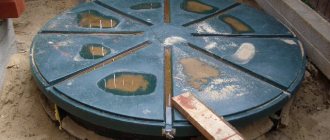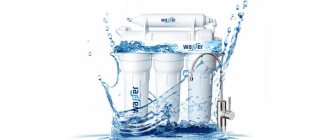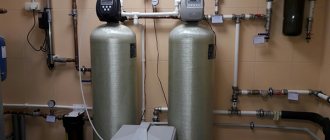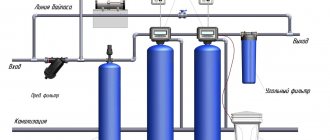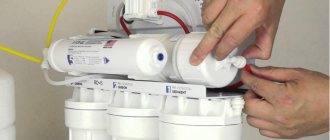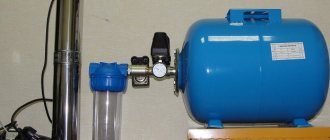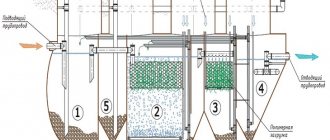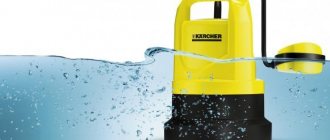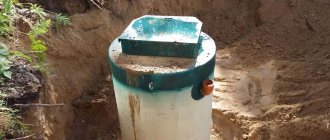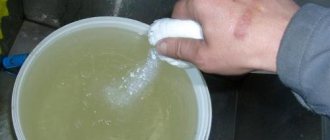How does an aeration station work?
Energy supply
These systems are 100% volatile. Such systems do not provide for non-permanent (seasonal) residence and were created as septic tanks for permanent residence for country houses and cottages with a stable supply of electricity. In case of frequent power outages, it is necessary to purchase a generator.
Compressor
Initially, 1 compressor was installed in aeration stations, but very often the solenoid valve failed.
Now they are equipped with 2 Chinese AirMac compressors, which operate alternately, and there is no solenoid valve. This event made it possible to make these septic tanks more reliable, their operation became more stable, despite all their energy dependence and over-complexity.
Photo. Compressors in an aeration station
The price for these vertical stations based on air supply inside is always approximately the same. First, the Czech station appeared, and later its analogue appeared with the same overall dimensions.
The operating principle of both models is identical, but it is believed that a septic tank with a solenoid valve is less reliable due to frequent switching. It contains a solenoid valve and 1 compressor: Japanese Hiblow or Chinese Secoh.
- The Hiblow compressor (Japan) is the undisputed leader among compressors. Pay attention to the series: the new XP series is not yet as reliable as the old HP. The Japanese Hiblow compressor is less noisy and more reliable.
- XP compressors are highly dependent on the quality of electrical energy (they often fail during power surges).
- Compressor Secoh (China) – No. 2 in Russia. Its cost is cheaper than Hiblow.
- AirMac compressor (China) - known only for its use in biological treatment aeration stations. Perhaps the marketing name plays on the corresponding names of Apple products.
Photo. Energy-dependent septic tank, vertical with one compressor inside
Cleaning efficiency from 70% to 90%
Restrictions. If we look at the passport for both treatment plants, we will see restrictions on the discharge of household wastewater into the sewer system. If you purchase stations, it is necessary to install the chopper under the sink in order to avoid the ingress of food residues and subsequent blockages.
Aeration water purification does not involve the use of mechanical filters (grease cutter, brushes, expanded clay loading, secondary settling tank, etc.). The output is milky water, odorless, but with impurities of fat and hair. Therefore, household wastewater must be further treated in soils (filtration fields). Both stations need to be pumped out 2 to 4 times a year.
If the system is de-energized for more than 3.5 hours, all aerobic bacteria that should be there will die. It will take about 4 weeks for the microorganisms to recover. All this time, such an aeration station for the home will reduce the cleaning efficiency at the outlet from 70% to 50% (the percentage of cleaning is indicated conditionally). There may be an odor.
Septic tank design
In order to deprive both yourself and those around you of such pleasure, you will need to install a functional modern model of a pumping (overflow) septic tank on your site. Its design consists of several compartments connected via a sewer pipe. In such septic tanks, wastewater first settles in the first shallow shaft, then it enters the second compartment, after which it undergoes biological treatment (oxidation-nitrification).
As a result, the output is purified liquid, which goes into the drain. All mineral insoluble substances settle to the bottom of the sump. When compared with a conventional septic tank, the quality of the second cleaning option is much higher.
When you decide to buy a septic tank, you need to pay attention to the type of material from which it is made.
Septic tanks made of polymer compounds (plastic)
The benefits include:
- economical price,
- ease,
- mobility,
- non-susceptibility to corrosion processes,
- ease of installation.
Flaws:
- standardly small in size (as a rule, a family requires several such septic tanks),
- insufficiently high level of resistance to fur. influences (a couple of diligent large rats can gnaw through the shell),
- there is the possibility of “squeezing out” an unfilled reservoir from the ground as a result of rising groundwater.
Metal septic tanks
Advantages include strength.
Flaws:
- the weight of the structure (for installation you have to use a crane),
- susceptibility to corrosion processes.
Concrete septic tanks
The benefits include:
- resistance to corrosion,
- strength,
- confidently resists soil water pressure.
Flaws:
- heavy weight (difficult to install),
- It is hygroscopic (usually it is necessary to create waterproofing).
Fiberglass septic tanks
The benefits include:
- non-susceptibility to rotting and corrosion processes,
- high strength,
- excellent resistance to aggressive environmental factors.
There are no disadvantages.
Air stations in winter.
Biological treatment aeration stations are based on the principle of intermittent aeration.
At the moment, there are several dozen similar systems on the Russian market. New brands are constantly appearing, and some disappear, unable to withstand the competition. Most of the aeration stations are clones of the Czech Topas, presented at an exhibition in Moscow in the late 90s by Jan Topol (TOPAS - TOPOL Activation System).
Photo. Aeration volatile station
Differences between aeration stations:
The design and operation scheme are the same for all. They may differ:
- quantity and quality of compressors (1 or 2),
- the presence or absence of a solenoid valve,
- availability and quality of the drainage pump,
- control unit,
- body thickness,
- quality of plastic,
- number of modifications according to the depth of insertion of the sewer pipe.
Disadvantages of aeration stations:
- A common disadvantage is the placement of compressors inside aeration stations.
Photo. Aeration station for biological treatment. Internal organization
- With this arrangement of the compressor in winter, cold air is supplied inside, so domestic wastewater can be cooled. When the water temperature drops below +10 degrees, bacteria enter into suspended animation and the quality of cleaning may deteriorate. The situation may change with non-permanent residence, when there is no influx of warm water and activated sludge for a long time.
- The optimal compressor operating mode is +5+25 degrees and no humidity. Inside the aeration station, the humidity is high, and temperature changes also occur, especially with non-permanent residence, so the life of the compressor is significantly reduced.
- No treatment facility is guaranteed against flooding, in case of poor quality installation. If the stations are flooded, the compressors and the control unit or terminal block will have to be replaced. Flooding can be caused by an overflow of the water intake (well, ditch), melt water getting under the cover or into the sewer pipe (an O-ring was bitten during installation or the pipeline was cracked due to the passage of vehicles). In the case of aeration stations, overflow can also occur due to problems with electricity, pump failure, clogged mamut pump or airlifts. Therefore, sellers of aeration stations convince customers to additionally install an alarm system and, in the case of seasonal residence, to mothball the station. But how will an alarm help if the whole family is on vacation?
Photo. Internal overflow of biological treatment aeration station
General disadvantages of energy-dependent aeration systems:
I. Constant blockages in aeration stations. The next common disadvantage is the pumping of wastewater from compartment to compartment using airlifts. A small clot of fat with hair is enough for a blockage to occur. Problems can arise from sand, toilet paper, and food debris.
II. An energy-dependent aeration water treatment plant has low reliability and requires increased attention. You may be faced with a situation where the sewer line backs up on New Year's Eve because you didn't instruct your guests or didn't keep an eye on your children.
Photo. Aeration station for biological treatment. Internal organization. Airlifts for pumping.
Photo. Installation diagram of anaerobic septic tanks with forced pumping into a ditch.
III. Low reliability of the biological treatment aeration station. The disadvantage of the installation scheme of aeration stations is the increase in energy consumption when groundwater enters the well and the likelihood of water freezing. Uninsulated drainage wells with this installation system can freeze in winter.
IV. 100% energy-dependent aeration stations for the home. For correct operation of aeration stations, an uninterrupted power supply is required. A power outage results in poor cleaning performance and the appearance of odors. If there is a power outage for a couple of hours, manufacturers recommend reducing water consumption over the next few days to restore the quality of cleaning. In addition, during a power outage or power surge, the risk of failure of the control unit and solenoid valve increases. It is recommended to install voltage stabilizers and enter into service agreements. Refusal of service may affect warranty obligations.
V. The need to preserve the aeration station in winter. If no one lives in a country house during the winter, the system requires conservation. Conservation involves the following steps:
- disconnect the septic tank from electricity
- clean out the septic tank
- disconnect and dismantle the pump and compressor
- drain excess water
- install 1 plastic bottle half filled with sand in each compartment of the septic tank
- additionally insulate the lid
Photo. Aerobic stations require conservation for the winter.
VI. Expensive annual maintenance of aeration stations. Due to the above disadvantages, the owners of aeration stations are forced to enter into service contracts every year. The price depends on the performance of the model and the distance from the service department, and usually starts from 15,000 rubles per year.
Additional charges:
- replacement of components (compressor, pump, solenoid valve, control unit)
- sewerage services (if permanent residence is required to remove sludge 4 times a year according to your passport)
- preservation for the winter
- re-opening in spring
- emergency call - on average from 5,000 rubles per call (in case of blockage)
- clearing the blockage
- defrosting frozen pipelines and systems.
Over three years of operation, on average, maintenance may cost an amount equivalent to or greater than the price of the aeration station. The components of aeration stations are specific. It may be difficult to purchase and replace the control unit.
